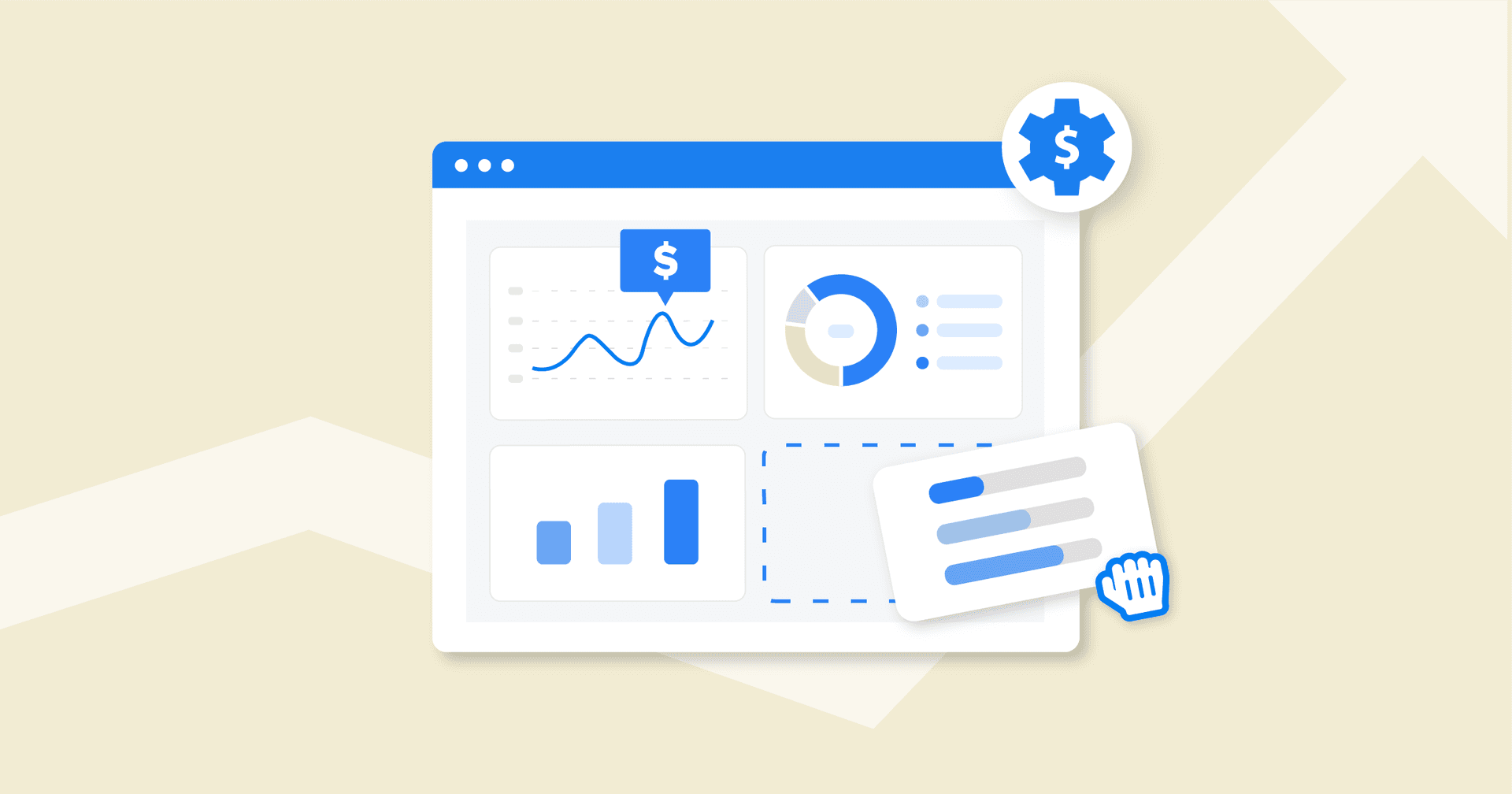Table of Contents
Table of Contents
- 2023 Agency Participant Breakdown
- Top 5 Marketing Agency Hurdles in 2023
- #1 Challenge Facing Marketing Agencies Today is Client Acquisition
- #2 Challenge Facing Marketing Agencies Today is Time Constraints
- #3 Challenge Facing Marketing Agencies Today is Cash Flow
- #4 Challenge Facing Marketing Agencies Today is Executing Client Deliverables
- #5 Challenge Facing Marketing Agencies Today is Client Retention
- Top Challenges by Agency Size
- Top Strategies for Client Acquisition
- Top 3 Client Acquisition Tactics
- A Reliable and Effective Approach to Acquiring New Clients
- How Often Do Agencies Win Sales Pitches?
- Percentage of Pitches Won vs. Agency Size
- Unlocking Team Excellence Is the Cornerstone of Agency Success
- Unlocking the Key to Client Retention
- How Long Do Most Agencies Retain Clients?
- Conclusion
7,000+ agencies have ditched manual reports. You can too.
Free 14-Day TrialMarketing agencies encounter diverse challenges that directly impact their success and growth. This comprehensive survey provides deeper insights into these agency struggles and sheds light on key operational areas, such as:
Effectively managing teams at scale, and
Embracing remote work.
As you assess your agency's performance, you may wonder how it compares to industry challenges. Are there areas where you can enhance your client acquisition efforts, improve team management practices, or optimize remote work strategies?
This report explores the various factors that impact these areas of operations, providing valuable insights and strategies to overcome the challenges inherent in the agency life cycle.
Part One of the 2023 AgencyAnalytics Benchmarks Report covers:
Interested in how things have evolved since? The 2025 Marketing Agency Benchmarks Report reveals the latest data on AI trends, client acquisition, team management, and more—check it out today.
2023 Agency Participant Breakdown
The 2023 AgencyAnalytics Agency Benchmarks Survey reached out to 121 agencies primarily located in the following regions:
United States (58%)
Australia (33%)
Canada (11%)
The United Kingdom (9%)

46% of respondents were agencies with 6-20 full-time employees. The distribution of clientele varied:
22% served 50-100 clients
19% managed 11-20 clients
16% handled 21-30 clients
15% served 31-50 clients
12% of agencies had either a larger client base of 100+ or a smaller, more concentrated clientele of 6-10
Only 4% of agencies worked with 1-5 clients
The agencies in the survey offer diverse services, with popular offerings including PPC, SEO, social media marketing, web design, and email marketing. However, it's worth noting that most agencies provide a combination of services to cater to their clients' comprehensive marketing needs.
The participants represent a diverse cross-section of the industry, providing us with insights into the unique challenges and practices faced by agencies of different sizes and markets. This comprehensive understanding enables us to present meaningful benchmarks and recommendations for agencies at varying stages of growth.
Top 5 Marketing Agency Hurdles in 2023
In a marketplace brimming with options, attracting and securing new clients has always been a critical pain point for marketing firms. This issue stands head and shoulders above the rest, including stress from time constraints, cash flow challenges, and executing on deliverables.
Let’s break down the five challenges agency owners put at the top of their list.

The 2023 Marketing Agency Benchmark Survey results show that:
37% of agencies note client acquisition as their top challenge
20% of agencies listed time constraints as their top challenge
13% of agencies reported cash flow as their primary concern
11% of agencies stated that executing client deliverables is their main concern
5% of agencies identified client retention as their main challenge
Let’s take a closer look at the numbers to gain a deeper understanding of these top obstacles that marketing agencies face today.
#1 Challenge Facing Marketing Agencies Today is Client Acquisition

37% of agencies identified acquiring new clients as their primary obstacle, surpassing other concerns such as time constraints and cash flow by a significant margin. Notably, agencies with 6-10 employees and a client base of 21-30 were particularly inclined to highlight client acquisition as a major challenge (but more on the unique challenges by agency size soon).
This trend may suggest that agencies strive for scalability, or may be indicative of a business model built on a shorter client life cycle. For example, an SEO agency may offer clients front-loaded activity with a website launch, resulting in several shorter contracts that need to be replenished by adding new clients to the pipeline with greater frequency.
#2 Challenge Facing Marketing Agencies Today is Time Constraints

Marketing is a deadline-driven, fast-paced industry. Unexpected project changes, client requests with quick turnaround times, looming pub dates, and last-minute media buys are all par for the course. Inevitably, even the best-laid plans often go awry, leaving the team to pick up the slack and continue to produce high-quality work with fewer hours than preferred.
If you thought your agency was the only one experiencing stress around time constraints, take heart in the fact that you’re not alone. 20% of the agencies we surveyed agreed that time remained a consistent challenge for them as well.
💡Increased stress around time constraints seems to only be moderately connected to an agency’s growth trajectory. 57% of the respondents who claimed time constraints as their top challenge had seen agency growth of 25% or more in the last year.
#3 Challenge Facing Marketing Agencies Today is Cash Flow

Ensuring a steady income stream while managing operational costs is a key aspect of agency sustainability. Being too tightly leveraged can lead to stress around paying employees, and even prevent agencies from taking healthy risks to grow the business.
Cash flow helps you meet your financial obligations. It helps you plan for the future. And it helps you decide when you need to push the accelerator or pull back–depending on what’s going on in your industry or amongst your team.
Dan Delmain, Founder of :Delmain
Cash flow management covers a wide range of agency facets, including ensuring that clients are billed appropriately, payroll and other financial outlays, optimizing account payables, and managing accounts receivables effectively. Consistent delays in client payments could be indicative of an accounts receivable process problem.
Optimizing account payables can unlock vendor discounts and maintain sufficient liquidity. Thus, the competency of the financial team in handling cash flow, understanding cash flow models, and making informed financial decisions is vital to the agency’s success and scalability.
💡47% of the agencies who chose cash flow as their top issue had more than 30 clients, with the highest level being within agencies with 50-100 clients. However, the 100-client mark seems to be a tipping point as only 7% of the agencies considering cash flow as their top priority had over 100 clients.
Cash flow represents an important temperature check on the health of the agency, so it’s no wonder why it’s a main concern for those we surveyed.
#4 Challenge Facing Marketing Agencies Today is Executing Client Deliverables

The execution of client deliverables ties into a number of different areas, including resource management, proactive communication, strong processes, efficient collaboration workflows, and client budgets.
In order to follow through and deliver high quality work, agencies also need to be adequately staffed. In some cases, this may mean adding freelance assets to accommodate large one-off projects, or new hires to meet the needs of a new contract.
Provided that agencies have effective resource management systems and processes in place, another primary challenge in executing client deliverables is budget. How often have you encountered clients with champagne taste on a beer budget? Top-notch agencies know how to stretch a dollar (especially when it’s in the name of an exciting project), but that resourcefulness comes with a cost: the stress of pulling off a big ask under less-than-ideal circumstances.
Delivering on the promises made to clients is key to reducing churn and improving client retention rates. After all, if client deliverables aren’t consistently met, the clients won’t stick around. This brings us to our 5th most important concern.
#5 Challenge Facing Marketing Agencies Today is Client Retention

Interestingly, out of all of the agencies we surveyed, only 5% noted client retention as a top challenge. Which is why it is at the bottom of the list, according to the 2023 survey. This insight highlights the importance of prioritizing client satisfaction, delivering exceptional results, and fostering strong relationships. Agencies that excel in client retention and reduce churn are likely to benefit from the trust and loyalty established with their clients, leading to sustained business growth and long-term partnerships.
To achieve this end, agencies need to foster the right skills within their employees and add the right tools to their workflows.
Given that all of the agencies surveyed are currently using the AgencyAnalytics platform, we know that these teams are consistently communicating their value to clients through frequent and professional reporting cadences. Is it a coincidence that so few of them struggle to retain clients? We think not.
By using AgencyAnalytics, we are able to provide our clients with insightful, accurate, and detailed reports that showcase the value we bring to their business. This level of transparency and clear communication helps build trust and strengthen our relationships with clients, which in turn leads to higher levels of client retention.
Adam Binder, Founder + CEO, Creative Click Media
Top Challenges by Agency Size
Now let’s take a look at this same data, parsed by agency size. For the purpose of our survey, we divided agencies into four groups.
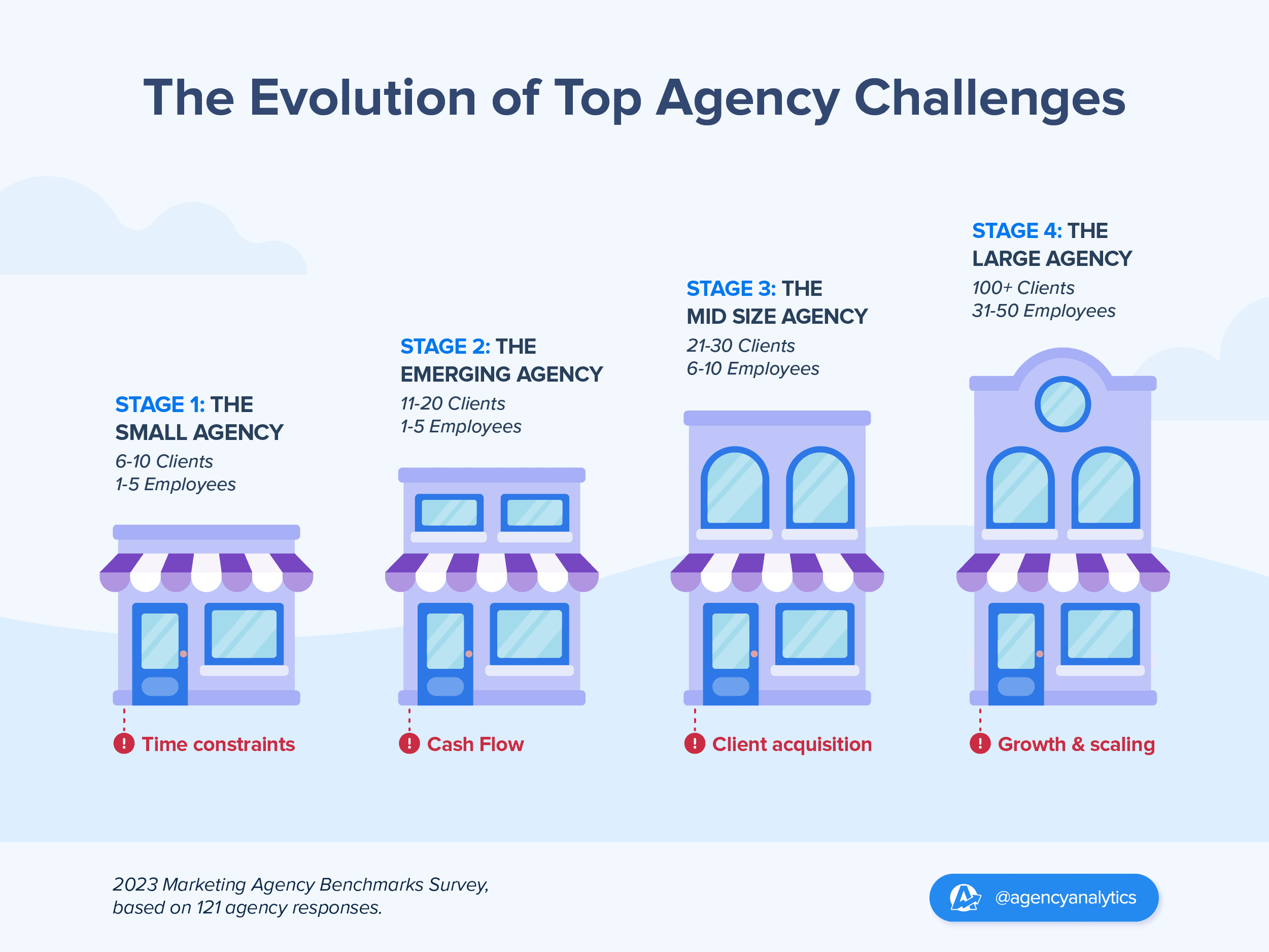
Small agencies: 6-10 clients and 1-5 full-time employees
Emerging agencies: 11-20 clients and 1-5 full-time employees
Mid-size agencies: 21-30 clients and 6-10 full-time employees
Large agencies: 100+ clients and 31-50 full-time employees
It’s interesting to note how the biggest challenges shift as agencies add on clients and grow their capacity. Below we’ll examine this more closely.
Small Agency Top Challenge
The data reveals that small agencies (6-10 clients and 1-5 full-time employees) predominantly identified time constraints as their main challenge.

This stage represents the initial phase of the agency owner's journey. Small agencies, typically in their early years, often have ad-hoc processes built in response to client needs in real-time.
Smaller budgets limit the ability to hire new team members as new projects roll in, and make it necessary to stretch existing resources instead. This naturally leads to time constraints and workflow bottlenecks, as small teams work to their maximum capacity in order to deliver on client expectations.
To keep the agency growing, small agency owners must sometimes take on clients and projects that aren’t necessarily the best fit; the luxury of being picky often comes later in the agency journey. It’s at this stage that some of the hardest lessons are learned: setting boundaries, understanding interpersonal dynamics, and communicating realistic expectations.
Stress runs high in these early days as client deadlines loom. But these growing pains are a necessary step along the path to the next phase of agency evolution: the emerging agency.
Emerging Agency Top Challenge
The survey responses indicate that emerging agencies (11-20 clients and 1-5 full-time employees) commonly face significant challenges related to agency cash flow.
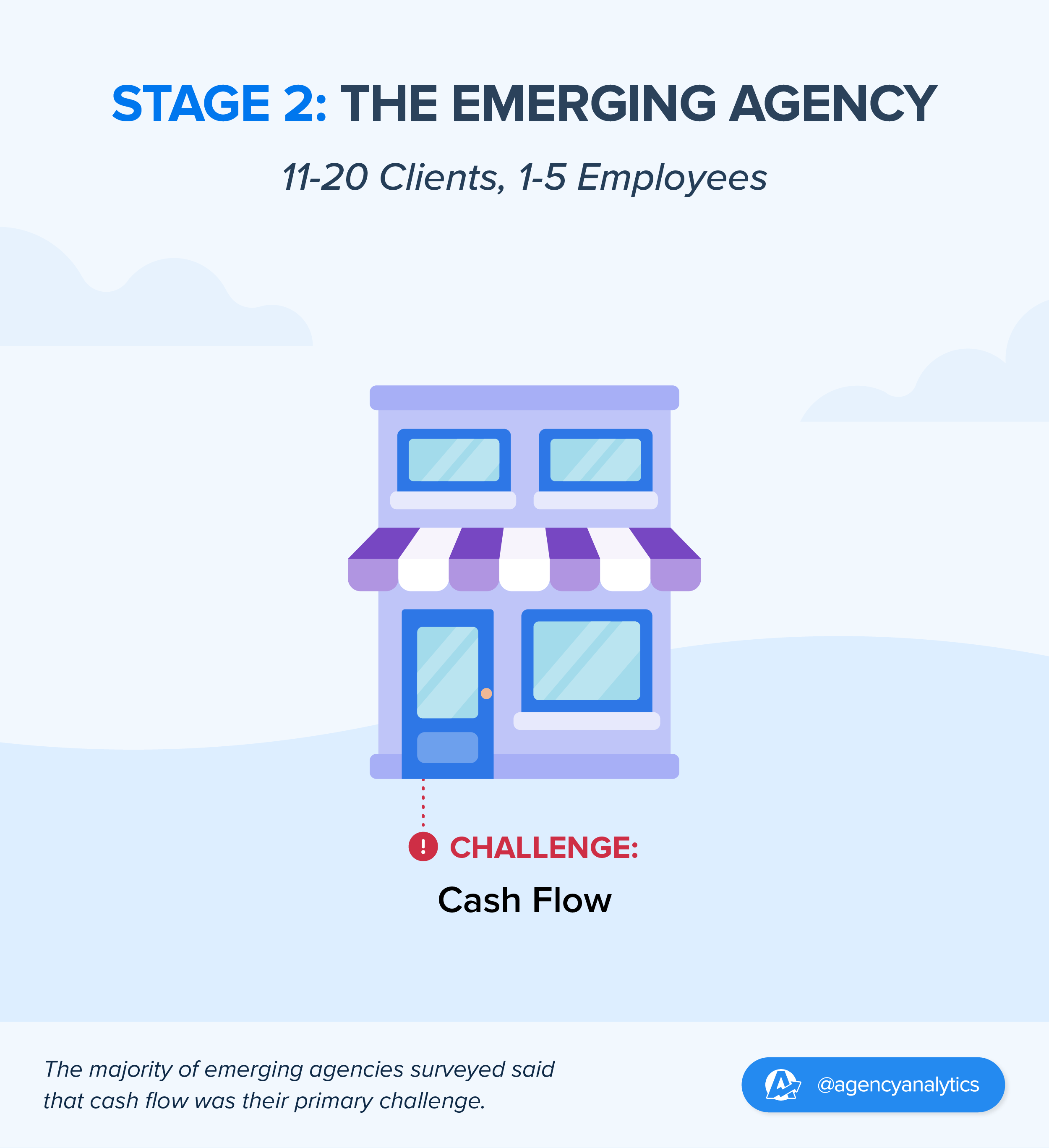
This phase represents a natural progression from the initial stage as the agency expands its client base and anticipates the need to hire additional staff. Here, managing agency cash flow is key to beating the financial pressures agencies face at each stage of the agency life cycle–especially breaking through growth plateaus.
This stage marks a critical juncture where financial management becomes a pressing concern for sustainable growth. Although this challenge is not exclusive to this agency size, it does seem to decrease as an agency grows and develops mature cash flow processes.
The emerging phase presents a delicate balancing act involving not just marketing productivity, but also efficient cash flow management. Marketing productivity requires agencies to navigate between managing client expectations, maintaining the quality of work, and ensuring profitability to maximize the utilization of billable hours.
Mid-Size Agency Top Challenge
The survey results indicate that mid-size agencies (21-30 clients and 6-10 full-time employees) list acquiring new clients as their main concern.

At the mid-growth stage, the agency has expanded its capacity by hiring more employees and establishing efficient systems. At this stage, it’s important to scale smart and use the right tools to streamline manual work and enable seamless communication. As a result, agencies improve their ability to onboard new clients and maintain strong relationships.
While pursuing growth, mid-size agencies seek to attract the right kind of clients rather than accepting anyone who comes their way. They may explore various strategies such as referral systems, niche refinement, and other tactics to acquire clients that align with their expertise and target market.
Our agency is able to provide accurate data in meetings with AgencyAnalytics, which helps client retention because the client is able to see and understand the data and results from the services we are providing for them.
Janeene High, CEO, Results Driven Marketing
Essentially, this mid-growth stage in the agency life cycle focuses on a strategic shift towards targeted client acquisition and retention, with a focus on quality over quantity.
Large Agency Top Challenge
The data indicates that large agencies (100+ clients and 31-50 full-time employees) face primary challenges related to growth and scaling the business.
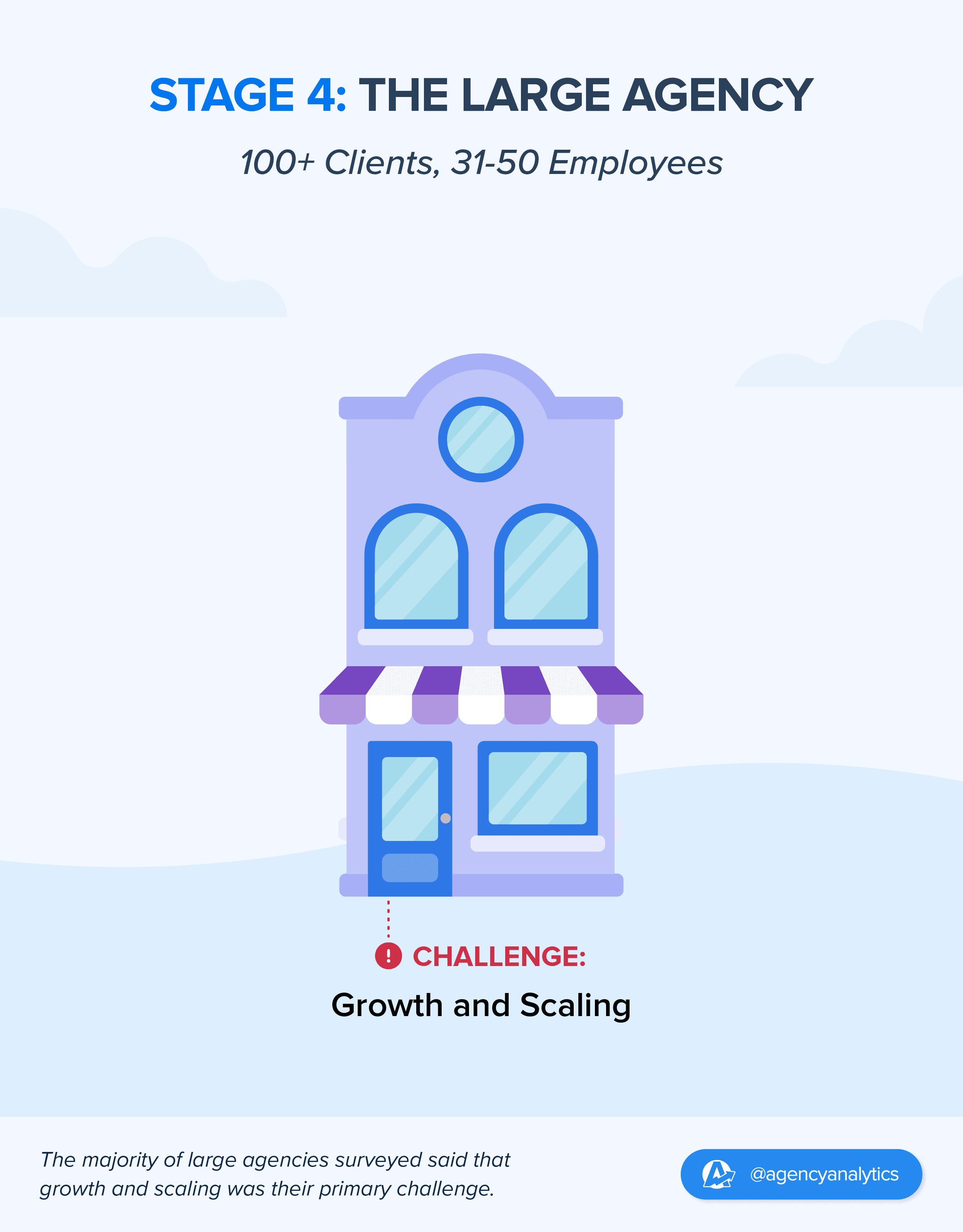
At this advanced stage, the agency has usually established its operational systems and has reached a size that attracts new clients. However, the main hurdle lies in effectively scaling and growing the agency in a sustainable manner.
The focus is not only on seamlessly onboarding new employees to meet the increasing demands of clients (without compromising the quality of service), but also on addressing the complexities that arise as the agency scales. This phase may require a focus on cultural changes, and reorganization of the agency's operational structure to efficiently handle the influx of new clients and additional employees.
Here, the goal is to ensure that the agency can expand while maintaining high standards and delivering exceptional service to its growing client base.
Retaining talented employees is essential for maintaining service quality and client satisfaction. Agencies must also consider implementing strategies for employee engagement, providing opportunities for professional development, and fostering a positive workplace culture.
As the agency scales, it might face other challenges, such as managing communication across a larger workforce, ensuring that the operational processes can sustain growth, and allocating resources efficiently.
At this stage, agency owners must develop their conscious leadership skills, as an agency’s culture is crucial to productivity and consistent success.
When asked, “What do you think about the next two years in the context of marketing agencies and growth?”, nearly all of the large agencies surveyed responded that they’re “quite optimistic”.
Top Strategies for Client Acquisition
As evident from the responses, client acquisition is a top challenge for most agencies. But it doesn’t mean they aren’t navigating this challenge with the right tactics. In this part of the survey, we asked agencies how they acquire new clients.
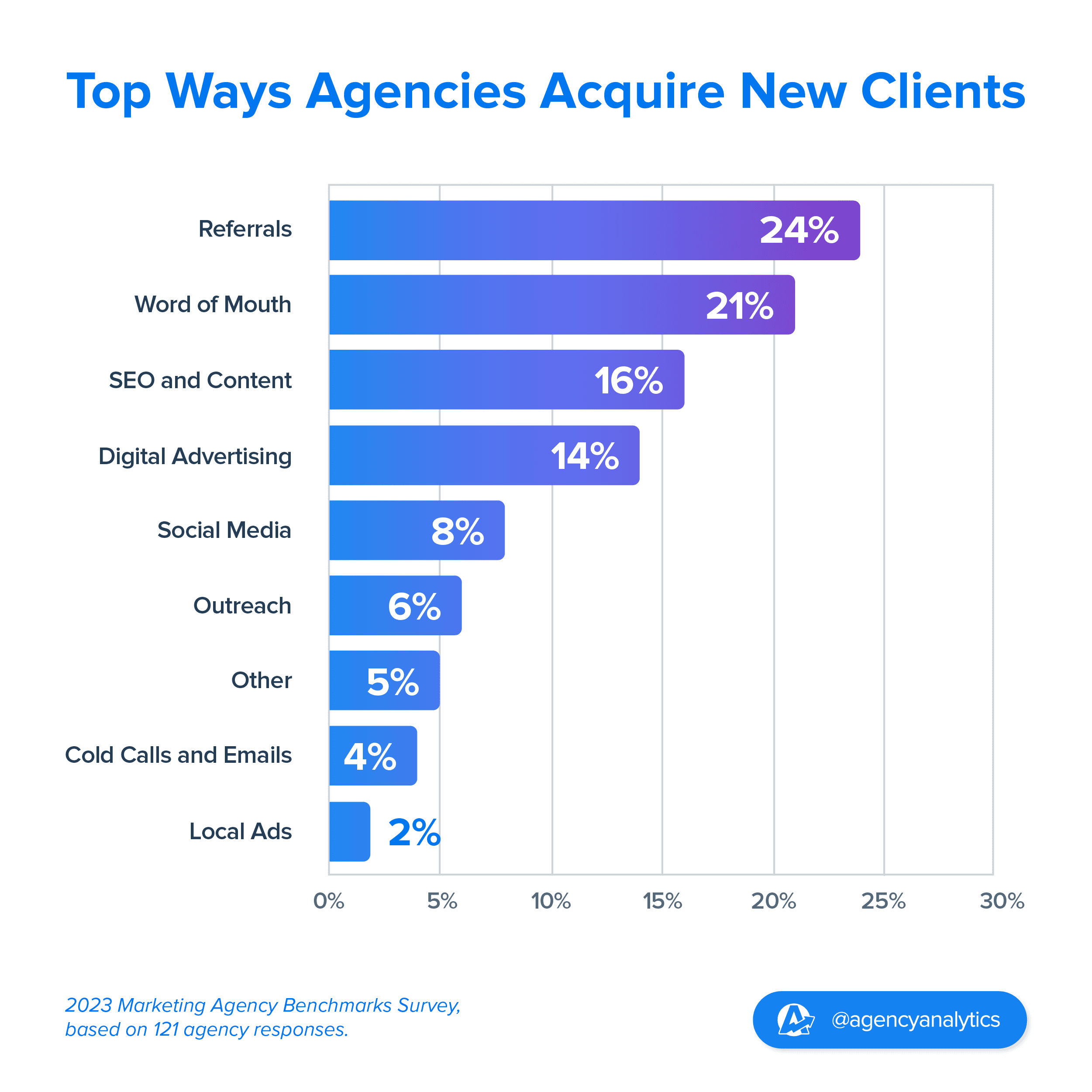
What marketing tactics are the most successful in attracting new leads? Let’s find out.
Interestingly, the survey found that personal recommendations proved to be more effective than digital marketing tactics for attracting new clients. Word-of-mouth and referrals were found to be more successful than PPC (Pay-Per-Click) advertising and social media strategies.
Top 3 Client Acquisition Tactics
Here are the top ways agencies attract new clients:
24% of agencies access new clients through referrals from existing clients
21% by general word-of-mouth
16% through SEO and content development
Meanwhile, cold calls, outreach, and social media fell to the bottom of the client acquisition strategies.
A Reliable and Effective Approach to Acquiring New Clients
By leveraging the potential of referrals, agencies tap into a reliable and effective source of new client acquisition.

The survey results indicate that 45% of agencies acquire new clients from recommendations and referrals.
24% of referrals come from existing clients
21% of referrals arrive via word-of-mouth
💡Referrals serve as a valuable endorsement of an agency's capabilities and can generate high-quality leads. To capitalize on this insight, agencies should focus on nurturing existing client relationships, providing exceptional service, and actively seeking referrals from satisfied clients.
When it comes to marketing, authority is everything. And creating a successful inbound marketing strategy is what will lead you to long-term, sustainable growth.

16% of the agencies surveyed state that they attract new clients through their own SEO and content efforts.
This practice seems to favor larger agencies, as 42% of the agencies who selected Content and SEO as one of their primary client acquisition channels had over 50 clients on their roster, but only 7% had a list smaller than ten clients.
That’s not to say, however, that paid advertising isn’t effective for client acquisition.

14% of agencies pointed to paid ads to get new prospects. Unlike organic strategies or referrals, which can take longer to build momentum, PPC campaigns typically focus on immediate conversions.
💡Agencies need to balance short-term gains from PPC with long-term client acquisition and retention strategies for sustainable growth and success in the competitive marketing industry.
How Often Do Agencies Win Sales Pitches?
In this part of the survey, we asked agencies how often they win a sales pitch. Since acquiring new clients was listed as a common top challenge for agencies, where does the main issue lie? Is it outcompeting in a dense market? Closing new leads?
What’s a good sales pitch success rate to benchmark against? Let’s find out.
Despite the challenge of landing new clients explored in this report, agencies are more likely to close a new deal than not, with 54% of the agencies surveyed reporting winning sales pitches at least half the time–if not more.
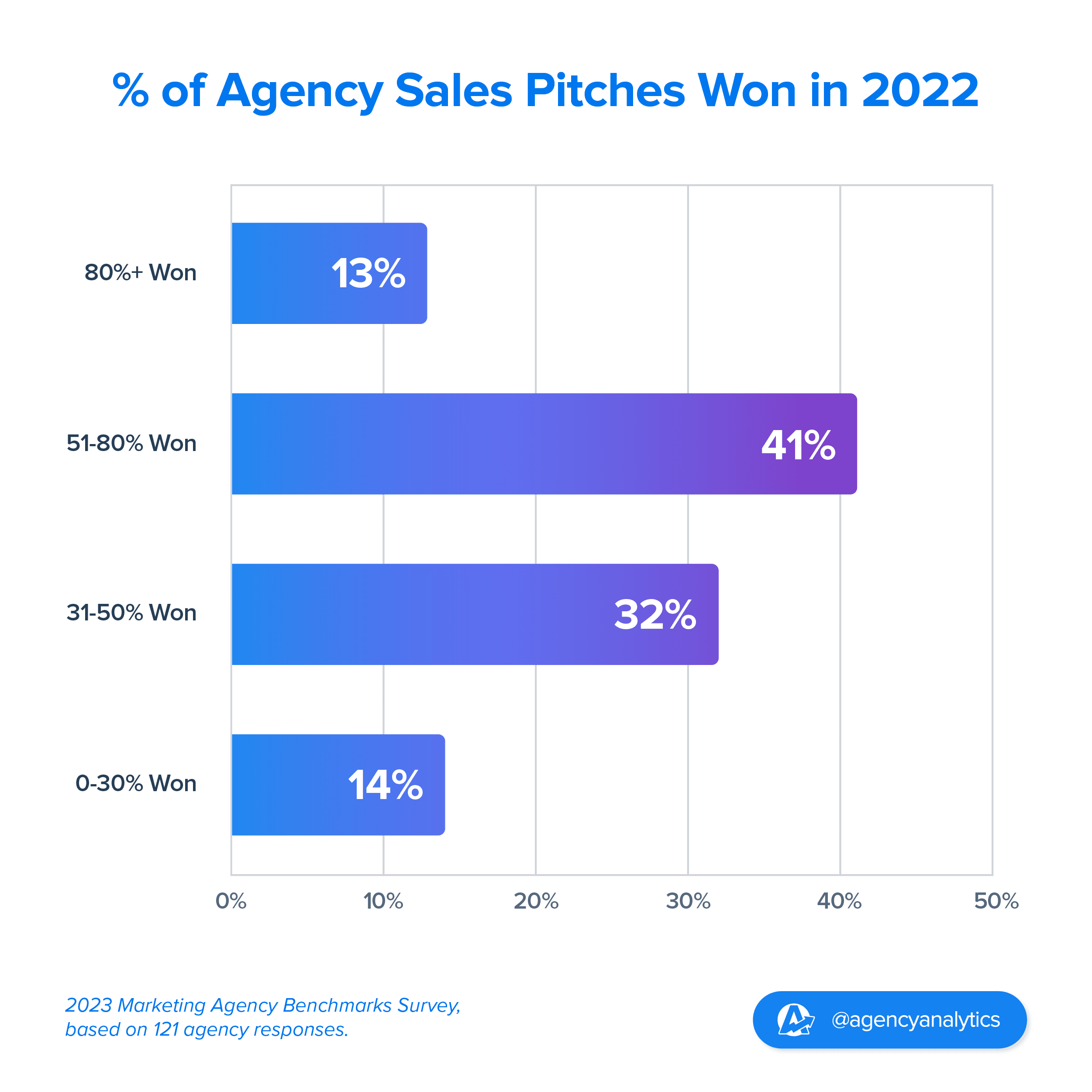
This relatively high success rate suggests that agencies surveyed have developed effective strategies, skills, proposal templates, and value propositions that resonate with clients and use the valuable information gathered in discovery meetings to their advantage.
One element of our sales pitch deck includes a preview of the AgencyAnalytics dashboard. Based on the data we can obtain for the client, we showcase an example of their site audit, Google tools, top 10 ranking keywords uploaded into rank tracker and we include a link to access report.
Ryan Stack, Co-Founder, The Stack Group
Percentage of Pitches Won vs. Agency Size
When looking at the data, we initially expected that the largest agencies would be the most successful at closing new deals. Interestingly, the smaller agencies stole the spotlight.
The results indicate that:
Agencies with 11-20 clients have the highest success rate, with 80% or more pitches won.
Agencies with 50-100 clients have a success rate of 51-80% in winning pitches.
Agencies with 31-50 clients typically win 31-50% of their pitches…
Coincidence?
The Coveted 80%+ Win Rate – How Likely Is It?

The survey results show that 13% of agencies have a sales win rate of 80% or higher. Such agencies demonstrate a higher level of expertise, improved client satisfaction, and/or persuasive capabilities in their sales pitch presentations.
The typical size of an agency with this win rate that we surveyed had 11-20 clients, which seems like the sweet spot where they’ve gotten over the challenge of client acquisition and have moved on to other growth challenges.
Agencies who consistently win their sales pitches may have a track record of delivering successful results, strong industry relationships in a highly specific niche, or specialized skills that make them more appealing to clients.
50%+ Win Rate at Decent Odds

The survey indicates that 41% of agencies win sales pitches more than half the time, which is at the higher end of industry averages.
I always think it's weird when someone thinks that our agency is too big to care about their small business. I always answer it by giving them a sincere response. "We started as a small business, and we treat every business that we work with as if it's our own."
Jyles Sosa, Ambassador of Web Domination, Fu Dog Media
It's noteworthy that most of the agencies with a 50%+ success rate have a client base ranging from 50 to 100 clients. This is likely representative of the fact that as an agency gains experience pitching new work, they improve their ability to:
Identify new clients and opportunities that align with their offering
Communicate their unique value in an RFP or pitch meeting
Share previous client success examples and testimonials as evidence of their expertise and fit for the project
Winning a 1/3 to 1/5 of Sales Pitches

Of the agencies surveyed, 32% said they win sales pitches 31-50% of the time, which is still a good win rate. Most of these agencies had 31-50 clients.
Overall, this information suggests that agencies with high win rates have a competitive edge, exceptional performance, and attributes that make them stand out in the pitch process.
The good news is that there is clearly potential for agencies with lower win rates to improve their strategies and capabilities, enhance their win rates, and gain more clients. It’s definitely possible to learn from prior success and continuously enhance pitch strategies and value propositions to remain competitive in the market.
Unlocking Team Excellence Is the Cornerstone of Agency Success
As we've explored the various challenges faced by marketing agencies, it becomes evident that an agency's performance is heavily reliant on its team. In this part of the survey, we asked agencies about their top internal team management challenges.
Let’s see what they had to say.
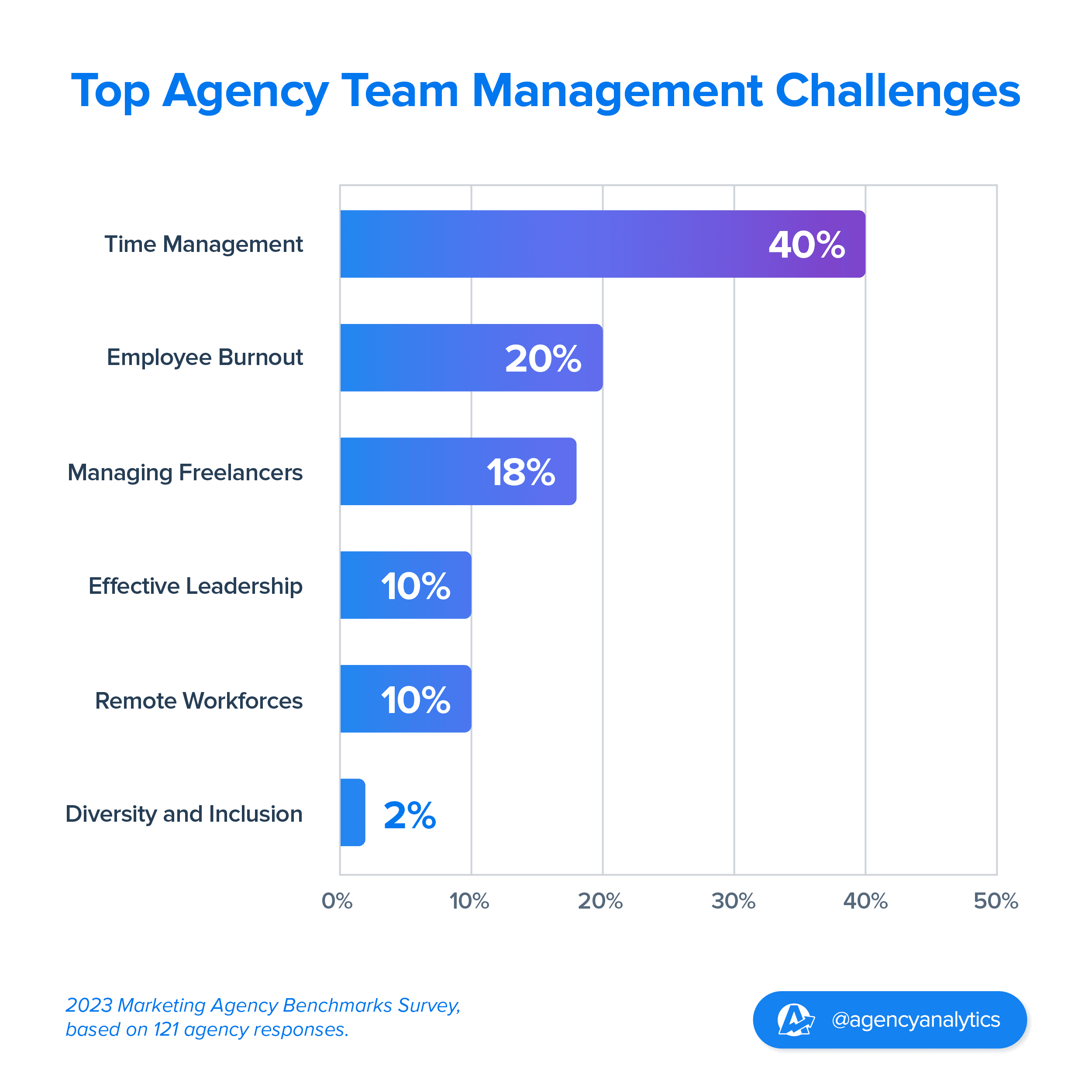
The survey results show that the top struggles agencies face at a team-management level are:
Allocating time and billable expenses to projects (40%)
Employee burnout (20%)
Managing freelancers (18%)
With a cultural shift in the workplace, including more hybrid work situations and the 4-day workweek becoming the norm, agencies place more importance on a healthy work-life balance. 10% of agencies face effective and compassionate leadership challenges, regardless of size.
Streamlining approval processes and employing remote work tools that support unlimited user accounts can be beneficial. These systems offer the flexibility for managers to adjust user permissions on a case-by-case basis, thus enhancing team coordination and efficiency.
💡Consider leveraging marketing agency tools and strategies to manage time pressures and meet client expectations. Utilizing appropriate remote work tools can address communication challenges and ensure quality control.
Another 10% of agencies indicated managing hybrid and remote workforces as a top team challenge. Notably, this issue was most prevalent among agencies with 1-20 full-time employees. Within this group, 85% outsource their work. Conversely, most larger agencies, those servicing 100+ clients, primarily operate from an office setting, adhering to a more traditional model. These larger agencies tend not to outsource much, if any, of their work to freelancers.
Only 2% of agency responses listed diversity and inclusion as a top team management issue, which was only mentioned by agencies with 50-100 full-time employees.
This suggests that smaller agencies may find it easier to hire diverse teams or that diversity isn’t currently top of mind as compared to other challenges that directly affect their agency’s bottom line. Meanwhile, agencies operating at a larger scale might struggle to hit their diversity and inclusion targets due to a complex organizational structure that limits their awareness of who makes up their organization.
Let’s dig deeper.
Top Team Management Challenge #1

This one tops our list of internal team challenges, with 40% of agencies listing allocating time and billable expenses to projects. It comes as no surprise considering the multiple clients and projects agencies handle simultaneously. Agencies of all sizes listed the allocation of time and expenses as a top concern. As an agency scales, logging hours and monitoring expenses for each project is a task that requires constant attention and adaptation.
Scaling a business requires time. When half of your business is losing time performing mundane tasks instead of working in productive ways, we effectively cap our expansion by slowing down how quickly things get done.
Ruben Roel, President & Founder, Investigator Marketing
This stat underscores the need for improved project management practices and tools that can enhance efficiency, transparency, and accuracy in tracking billable hours and project-related expenses to stay ahead of scope creep.
Top Team Management Challenge #2

Employee burnout emerges as the second most common challenge, with 20% of agencies mentioning it as a top struggle in the survey. No matter the size of the agency, burnout is prevalent due to the fast-paced nature of the industry.
Long hours, high expectations, and tight deadlines often lead to stress and exhaustion among team members. However, things are changing, and the status quo is slowly shifting away from the traditional hustle culture. Employees value a healthier work-life balance. Leaders need to create an environment conducive to their well-being because it’s crucial for building winning teams.
Top Team Management Challenge #3

A significant challenge for agency team management is managing their freelancers, with 18% of agencies listing it as a top concern. Agencies increasingly outsource certain tasks, such as content creation to meet project needs. However, tracking freelancers’ project goals and deadlines is harder when employees fall outside of an agency’s internal process stack.
With freelancers scattered across different locations and time zones, finding the right freelancers, effective communication, and quality control become crucial.
Top Team Management Challenge #4

The global pandemic has led many agencies to adopt flexible work models, so it comes as no surprise that 10% of agencies list managing hybrid or remote workforces as a top team management challenge.
A quick transition to flexible work didn’t come without its hurdles, mainly with the unique challenges of maintaining productivity, fostering team cohesion, and improving internal communication.
Top Team Management Challenge #5

Effective leadership emerges as a team challenge for agencies of all sizes. 10% of agencies surveyed emphasize the struggle with conscious leadership. This attribute might be the antidote to burnout mentioned above, as it requires leaders to be dedicated to ongoing learning and to continually strive for excellence.
The days of traditional top-down management approaches are fading as people now seek leaders who empathize with their teams, aim to resolve issues and inspire them to reach their fullest potential. By fostering compassionate leadership, agencies create a supportive environment that motivates employees to perform at their best.
When people feel valued, they naturally deliver their very best work. The happier, healthier, and more valued they feel, the more engaged, excited, and hungry they'll be to deliver their best.
Michelle van Blerck, Communications Manager, Digital Freak
Top Team Management Challenge #6

In the survey, only 5% of agencies reported struggling with retaining top talent, regardless of their number of employees or clients. This suggests that employee retention isn’t a major issue for most agencies. Talent retention issues often stem from marketing burnout, which happens when agencies mismanage time and struggle to meet client expectations.
Agencies need effective strategies to attract and retain talented professionals within their organizations by creating a positive work environment, fostering employee engagement, and providing opportunities for growth and advancement. Luckily, many of these issues can be mitigated by promoting an agency culture that engenders a positive work environment–cue the virtual team-building activities.
By focusing so much on the happiness of each individual employee, we ensure better outcomes for our clients as well. We know this people-first strategy works because our employee and client retention rate is incredibly high.
Graham Lumley, Director of Marketing, Blackhawk Digital Marketing
Investment in employee well-being and ongoing learning leads to stronger teams and a culture of loyalty and longevity. In turn, agencies see improved productivity, client satisfaction, and overall business success.
Unlocking the Key to Client Retention
While client retention did not emerge as a key concern for the majority of the agencies we surveyed, it’s still a factor that’s worthy of attention and exploration. According to the numbers, agencies with 20+ clients struggle with client retention the most. Let’s take a look at some of the driving factors behind establishing (or maintaining) a high retention rate.

Based on our survey, 36% of respondents stated effective communication and transparency are key factors in influencing client retention. Next was campaign performance, with 30% of agencies listing that as their number one tool for client retention.
Not surprisingly, people skills took priority over campaign performance–how you communicate your success is often more important than the results themselves.
Method #1: Effective Communication and Transparency

36% of agencies attribute client retention to effective communication and transparency. This suggests that clear and open lines of communication, along with transparency in the agency-client relationship, play a significant role in maintaining client satisfaction and trust.
Demonstrating value via regular check-ins, a reliable reporting schedule, and a willingness to discuss both successes and challenges is what deepens client relationships and sustains connection over the long term.
Client reporting is an essential part of any digital marketing campaign. By providing regular reports, businesses can see that their agencies are working hard to deliver results. This transparency is crucial for building long-term relationships between businesses and their digital marketing partners. In short, client reporting is a vital part of any digital marketing strategy and should not be overlooked by businesses or agencies.
Guy Hudson, Founder, Bespoke Marketing Plans
Method #2: Strong Campaign Performance
The survey results show that 31% of agencies attribute campaign performance to client retention.

Showing what you are capable of doing for your clients is the best way to show value. We have increased our percentage of ad management spend over the past year due to our success with clients by showing their ROI.
Blake Baxendell, CEO, Wahha Design
This indicates that agencies that consistently align with client success, achieve positive outcomes, meet client objectives, and demonstrate the effectiveness of their campaigns are more likely to retain clients over the long term.
Method #3: Maintaining Strong Working Relationships

Of the agencies surveyed, 28% say that a strong agency-client relationship is key to retaining clients.
I believe reporting and attribution to be key factors in client retention, but without relationships and communication, client retention does not exist.
Christopher Marrano, Founder/CEO, Blue Water Marketing
Agencies that invest in fostering positive relationships, understanding client needs, and providing exceptional customer service are more likely to retain clients for extended periods.
Method #4: Flexible Pricing

A small percentage (4%) of agencies attribute client retention to flexible pricing. This indicates that some agencies may differentiate themselves by offering pricing structures or models that align with client budgets, providing flexibility and accommodating different financial requirements. This is also a lower barrier to entry for hesitant clients or smaller businesses with smaller marketing budgets.
Keep pricing simple initially and ensure clients are clear about what they receive. As the relationship develops, you can discuss the opportunities and bespoke your approach and pricing.
Richard Jaggs, Founder, Resolution Design
How Long Do Most Agencies Retain Clients?
As we have seen, client retention isn’t a primary challenge for many agencies. In this part of the survey, we asked agencies how long they tend to retain clients.
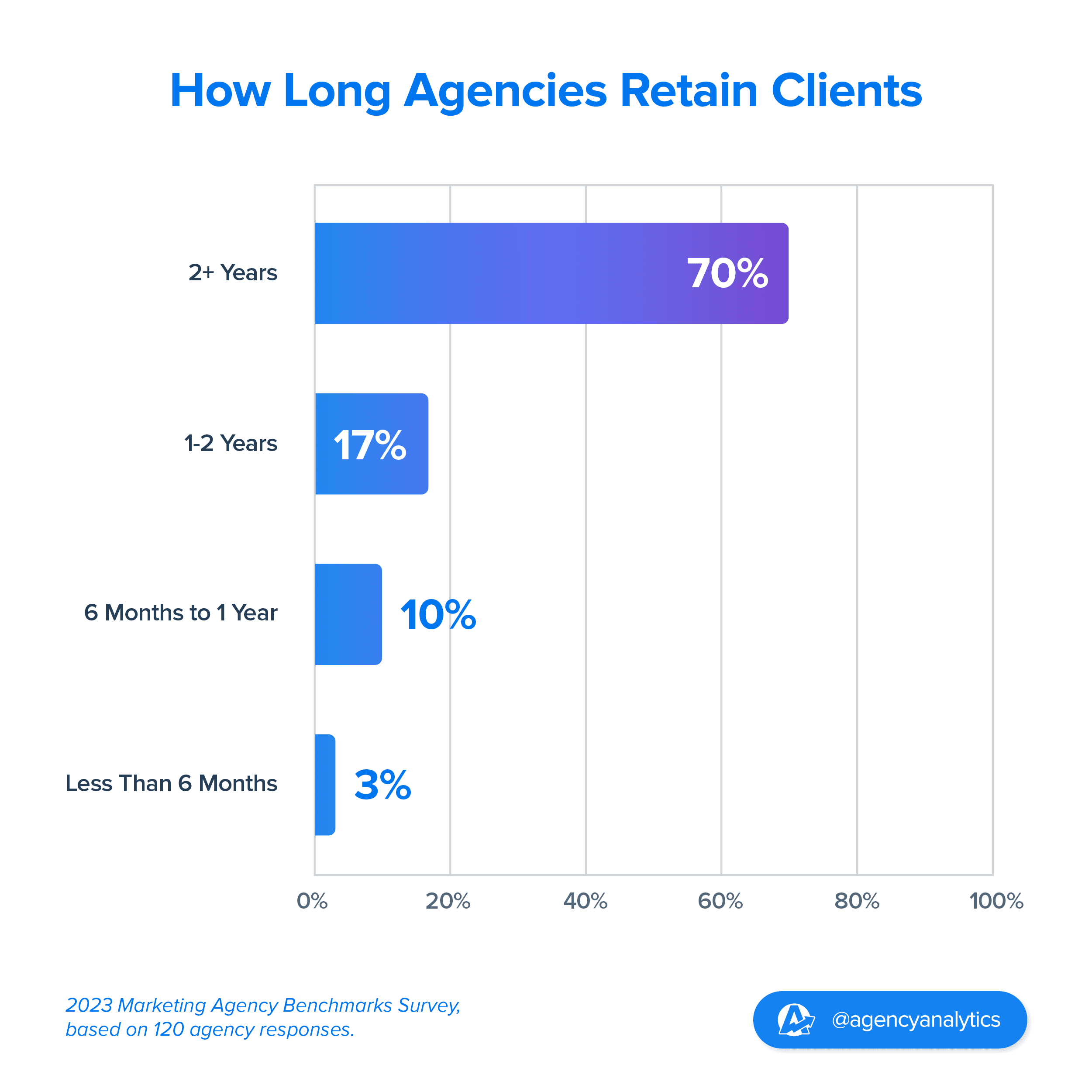
The agencies surveyed showed varying durations of client retention:
The majority, 70% of the surveyed agencies, reported retaining clients for over two years
Another 17% retained clients for 1-2 years
10% retained clients for six months to a year
Only 3% retained clients for less than six months
It is interesting to observe that agencies with shorter client retention periods often focus on a narrower range of services, specifically PPC, SEO, social media marketing, and local marketing.
This could indicate that these areas may not have as much stickiness or that highlighting successful results and maintaining client satisfaction may be more difficult. By contrast, agencies offering a broader range of services may be more likely to establish and sustain longer-lasting client relationships.
The Coveted 2+ Year Client Retention Rate

According to the survey, 70% of the agencies (all of whom use the AgencyAnalytics client reporting software) have a client retention period of two or more years. This suggests that these agencies excel in maintaining strong and long-lasting relationships with their clients. They are able to effectively meet their clients’ goals and demonstrate their positive impact consistently through in-depth, frequent, professional reporting cadences.
KPIs allow us, as the agency, to demonstrate our value to the client. There are basic KPIs such as spend, clicks, impressions, ranking, etc., but the real KPIs every client wants to know are leads and/or sales. We like to include both in our monthly reports. Ultimately, what is their ROI from our efforts? When you can clearly demonstrate this month over month, it increases your retention rate and keeps clients paying you month after month.
Jacob Hicks, Owner, Magnyfi
Reaching the 1-2 Year Mark Before Clients Drop Off

According to the survey, 17% of agencies surveyed retain clients for a duration of 1-2 years.
Although not as long as the previous category, this retention period still indicates a certain level of client satisfaction and successful project outcomes.
It's worth noting that in industries such as SEO and social media, results often take some time to become apparent. This period corresponds with the time during which clients evaluate the performance and efficacy of the agency they've hired. If a client decides to switch agencies during this timeframe, it could indicate that the agency has not met expectations or objectives in this crucial evaluation phase.
Additionally, clients ending their engagements after the 1-year mark could be attributed to changing client strategies based on market conditions or the natural duration required to complete a particular project.
The 6 Months to 1 Year Mark

10% of agencies retain clients for six months to a year. This category likely includes agencies that work on shorter-term projects or have a higher turnover rate of clients due to various factors such as project nature, industry dynamics, or client preferences.
It’s Rare To Keep Clients Less Than 6 Months

Only 3% of the surveyed agencies indicated that they retain clients for less than six months. This suggests that a relatively small number of agencies face challenges in meeting client needs within a short timeframe, possibly due to time constraints or difficulties in delivering immediate value.
This finding implies that building strong and lasting client relationships within a short period may require additional attention and effort. However, it is also possible that these agencies fall into a consultancy role, where the nature of the projects they handle is typically short-term.
Conclusion
This section of the 2023 Annual Marketing Agency Benchmarks Survey has provided valuable insights into the top challenges faced by marketing agencies and strategies to overcome them. It becomes evident that acquiring new clients, managing teams effectively, encouraging employee personal growth, and embracing remote work are key areas agencies must focus on to drive growth and success.
By implementing the recommended strategies and approaches discussed in this report, agencies optimize their client acquisition efforts, improve team management practices, and adapt to the rapidly evolving digital marketing landscape. These efforts ultimately lead to enhanced client satisfaction, increased client retention, and sustainable business growth.
Share the insights from this report on your social media channels to inspire and inform your peers by tagging us @AgencyAnalytics. And check out the 2025 Marketing Agency Benchmarks Report for the latest data-driven trends and insights!
Bookmark All Four Parts of the 2023 Marketing Agency Benchmarks Report
Part One - Overcoming Top Barriers To Agency Growth |
Part Two - Marketing Agency Management Insights |
Part Three - Marketing Agency Growth Insights and Future Channel Strategies |
Part Four - Trends In Agency-Client Reporting |
In line with our commitment to sustainability, we are thrilled to announce that for every agency that participated in the survey, we have planted a tree through our partnership with Evertreen. Together, we are making a positive impact on the environment.

Written by
Melody Sinclair-Brooks brings nearly a decade of experience in marketing in the tech industry. Specializing in B2B messaging for startups and SaaS, she crafts campaigns that cut through the noise, leveraging customer insights and multichannel strategies for tangible growth.
Read more posts by Melody Sinclair-BrooksSee how 7,000+ marketing agencies help clients win
Free 14-day trial. No credit card required.




